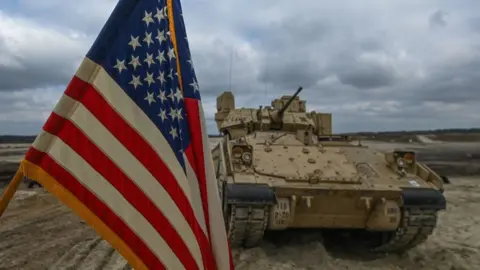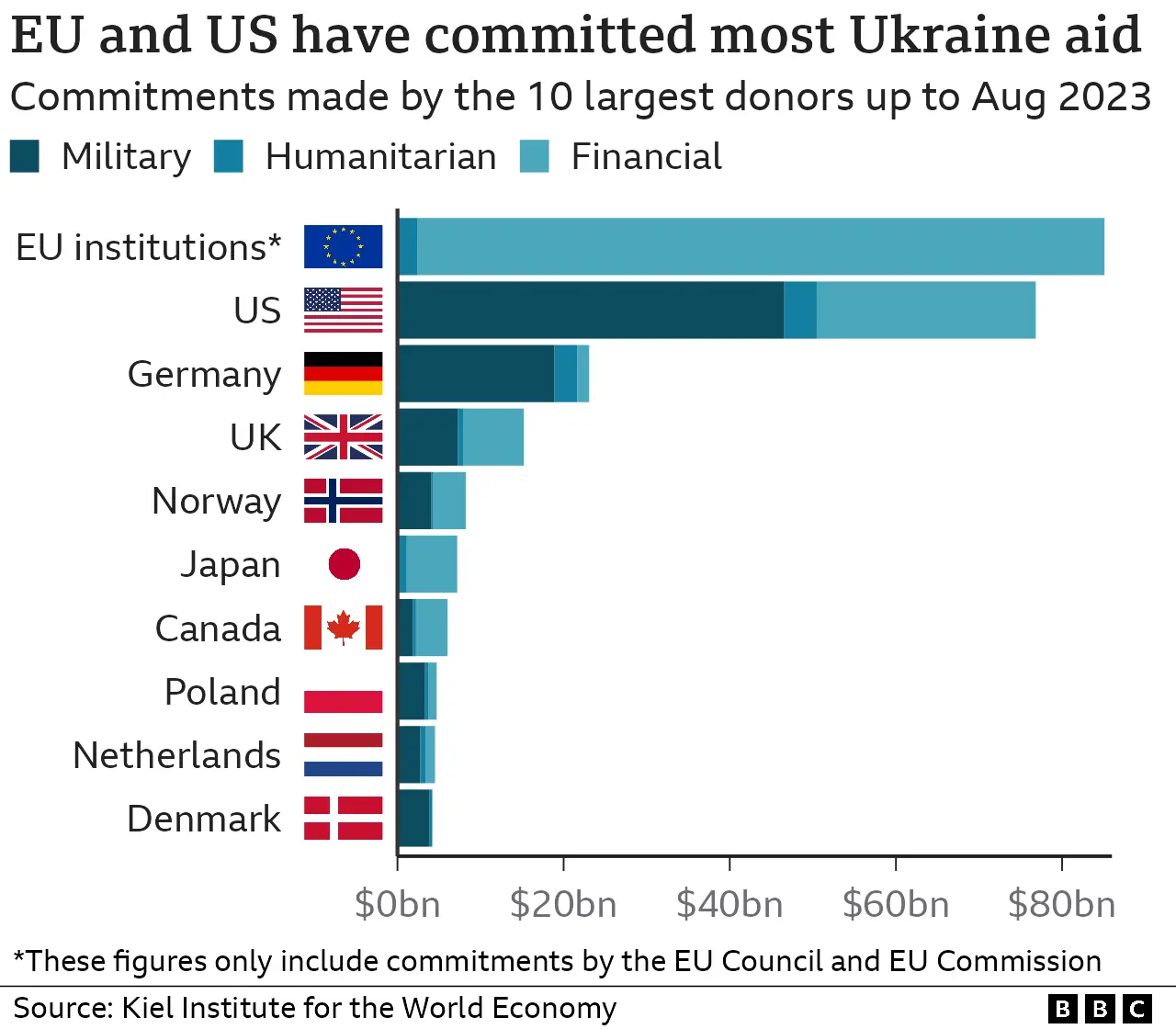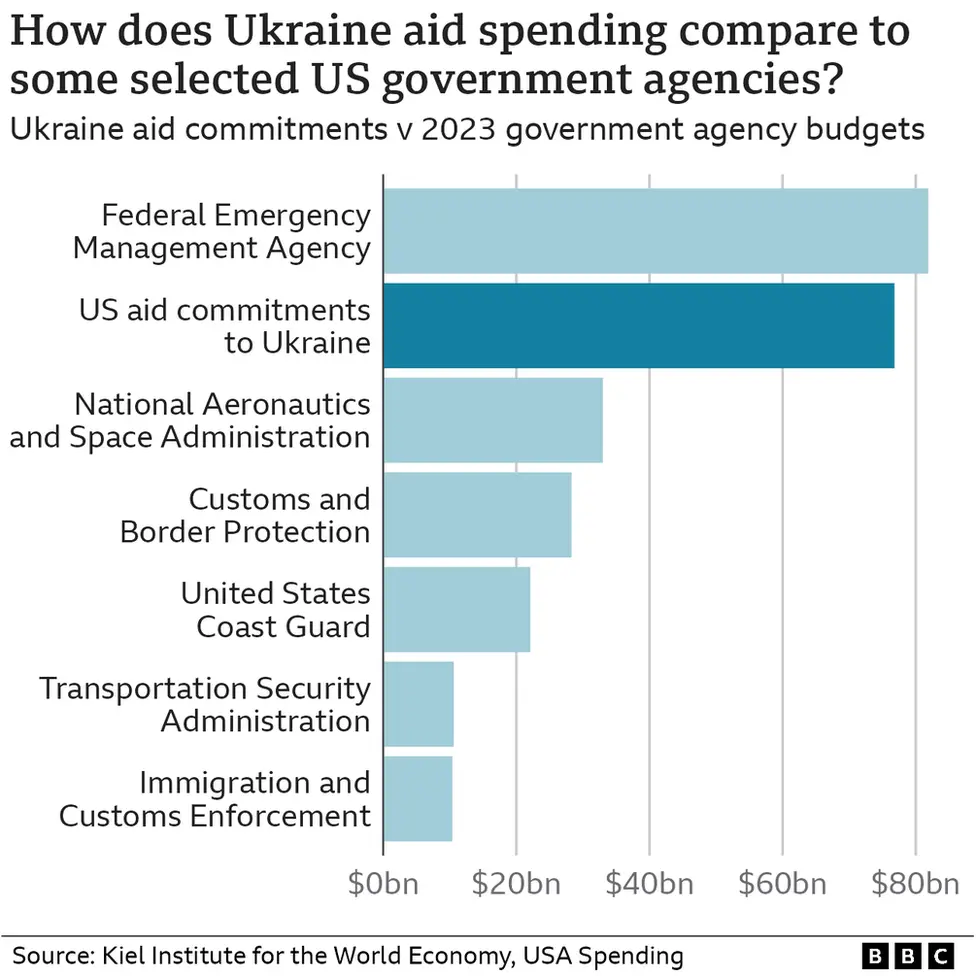How Norway outstrips US on Ukraine spending
 Getty Images
Getty ImagesThe United States has poured more than a hundred billion dollars into Ukraine's effort to repel Russia's invasion, spending far more than any other nation. But as President Volodymyr Zelensky comes to Washington to ask for more, there is growing Republican scepticism about funding the war effort.
In his Tuesday speech to the UN, Joe Biden made a passionate plea for the global community to not turn its back on Ukraine.
"Russia believes that the world will grow weary and allow it to brutalise Ukraine without consequence," he said. "But I ask you this: If we abandon the core principles of the United States to appease an aggressor, can any member state in this body feel confident that they're protected?"
For more than a year and a half, the US president has followed up that tough talk with American dollars. The US Congress has now authorised more than $110bn (£89bn) in aid to Ukraine. That includes:
- $49.6bn in military assistance
- $28.5bn in economic support
- $13.2bn in humanitarian aid
- $18.4bn to boost US defence industry capacity
As of 9 August, the White House said it had spent 91% of the allocated funds. The administration is currently asking Congress for an additional $24bn in aid, including $14bn in military support.
However, polls suggest support among Americans for further spending has declined, especially among conservatives.
So as President Zelensky visits Washington to make his case in person, let's take a closer look at the numbers, including why Norway not the US may actually be Ukraine's biggest supporter.
How does US support for Ukraine compare?
The latest figures which enable us to compare levels of support across countries are from the end of July. At that point, the US had spent nearly $80bn on Ukraine, which was more than any other nation by far - although it is less than the aid from EU institutions.

The outlook for a speedy approval of the funds is murky, however, as Congress grapples with passing funding just to keep the government open and functioning beyond this month.
Alyssa Demus, an international defence researcher for the Rand Corporation, says that without this additional aid, the Ukrainian counteroffensive that began this summer could grind to a halt in a matter of weeks - sending a negative signal just as Ukraine is making some "relatively significant" gains on the battlefield.
With winter coming, she says, Ukraine will eventually curtail its military operations regardless of whether the US aid is forthcoming. But, she adds, a new US aid package would have an impact on the war beyond the battlefield.
"The US tends to set the tone for other nations' aid," she says. "A lack of new US aid could be a bellwether for European allies and partners to potentially reconsider their own aid packages."

While the US gives the most military support of any nation, the combined contribution from European nations is significant - and includes advanced technology, such as tanks and fighter jets.
Growing Republican calls to slow or stop spending
The Biden administration's insistence that additional military aid is essential hasn't stopped some American politicians - particularly Republicans - from criticising the Biden administration's Ukraine aid packages and pledging to oppose any new funding.
"There's no national security interest for us in Ukraine," said Kentucky Senator Rand Paul. "And even if there were, it would be trumped by the fact that we have no money."
Speaking to media after attending a closed-door briefing, Missouri Senator Josh Hawley said he was tired of being told to "buckle up and get out your chequebook".
"This isn't our money. For heaven's sake… It's the American people's money," he said.
According to Luke Coffey, a senior fellow at the Hudson Institute, a conservative think tank, US aid to Ukraine is an easy issue for some Republicans to dislike, given the nation's connection to Donald Trump's first impeachment and Hunter Biden's questionable ties to a Ukrainian energy company.
"Even though both of these issues are not linked in any way to the war, if you're playing swamp politics, then you can quickly build an anti-Ukraine narrative that resonates with a certain part of the conservative movement," he says.
Among the more common refrains from a growing number of Republicans in Congress is that US dollars would be better spent on other priorities - particularly on domestic concerns like border security, disaster relief and crime control.
US aid to Ukraine pales when compared with the $751bn 2022 US budget for defence spending or the $1.2tn paid out in Social Security retirement benefits, however. It is also just 1.8% of the total US spending in the 2022 fiscal year.
On the other hand, the nearly $80bn given to support Ukraine by the end of July is bigger than the annual budgets of many federal agencies.

It is also a level of aid that far surpasses previous major US foreign commitments. According to data compiled by the Council on Foreign Relations, US support to Ukraine as of July was 0.33% of it the nation's gross domestic product, far more than US aid to Israel in 1970 (0.18%), Latin America in 1964 (0.15%) and Pakistan in 1962 (0.08%).
Even by modern standards, the Ukraine package dwarfs amounts sent by the US to other countries. In 2020, the US gave $4bn in support to Afghanistan, $3.3bn to Israel and $1.2bn to Iraq.
As with other forms of foreign aid, critics have called for US allies to shoulder a greater share of the costs of the war.
"Europe needs to step up," Florida Governor Ron DeSantis said at last month's Republican presidential candidate debate in Wisconsin. "Our support should be contingent on them doing it."
While the US does contribute more military support to Ukraine than its allies, in term of total aid the European nations - individually and under the auspices of the EU - have committed $140bn to Ukraine, which outpaces the US.
Coffey adds that comparing raw dollar amounts also understates the level of support from the US's partner nations.
"You can't compare what the US is doing in Ukraine with what Estonia is doing," he says. "Estonia has an economy the size of Vermont."
A better measure, he says, is to compare aid as a share of a country's gross domestic product.

According to data gathered by the Kiel Institute for the World Economy, as of the end of July Norway had given the highest percentage, at 1.4%. Estonia and the two other Baltic states bordering Russia all also give over 1%.
What it comes down to, Demus says, is a matter of perspective. For some, Ukraine is a distant country that many Americans don't know or care about.
For others, it's a key battleground of a global conflict, with the US helping a nation to defend its territorial integrity and sovereignty while also degrading a foreign adversary at a (relative) bargain price and without the loss of US lives.
"If you're talking about pure cost-benefit analysis," she says, "it kind of depends on what you value."

Sign up for our morning newsletter and get BBC News in your inbox.


